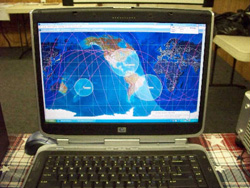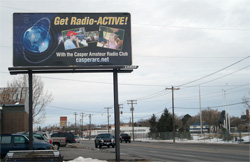- New Logo
- World Amateur Radio Day – April 18
- A Field Day Experiment in PR
- Cell Phone Bans - know the arguments
- Successful Fair Displays
- Billboards
- Skywarn Logo Restrictions and You
- Opportunity Knocks in Severe Weather Week
- Newspaper Headlines from Almost Anywhere
- Don’t forget this opportunity
- The Last Word
New Logo
World Amateur Radio Day is coming – April 18, 2009
Hans Zimmermann, F5VKP/HB9AQS, IARU International Coordinator, writes...
Amateur Radio: Your Resource in Disaster and Emergency Communication
Each year on 18 April, radio amateurs celebrate World Amateur Radio Day. On that day in 1925 the International Amateur Radio Union (IARU) was founded. In 2009, the theme of the event is Amateur Radio: Your Resource in Disaster and Emergency Communication.
It is not by coincidence that last year’s meeting of the IARU Administrative Council chose this subject at this time. While the Amateur Radio Service has traditionally made its contributions to emergency and disaster response ever since its very beginnings almost 100 years ago, this role has gained a lot of importance just in the recent past. It has done so mainly for two reasons:
* The number and dimension of natural as well as man-made disasters is unfortunately on the increase, and
* The modern communication technologies are increasingly complex, infrastructure-dependent and therefore also increasingly vulnerable.
The Amateur Radio Services puts two equally valuable assets at its disposal for emergency and disaster prevention, preparedness and response:
* A large number of very flexible and mostly infrastructure-independent, local, national, regional and global networks, and
* A large number of skilled operators, who know how to communicate with often very limited means and to establish communications even under the most difficult circumstances.
The tools at their disposal range from the most robust means such as battery-operated stations operating in Morse code to links through amateur radio satellites and interconnectivity with the Internet, in voice, text, image and data modes. They range from local VHF networks of fixed, mobile and portable stations to shortwave networks that span the globe. All these networks are operated on a daily basis by men and women who are thoroughly familiar with their technology and their intricacies.
Telecommunications have become a commodity that society takes for granted, and the sudden loss of that service is often felt in a similar way to the loss of shelter, food and medical support. When disasters occur in regions that do not have good coverage by public networks, or when existing communications infrastructures have just been disrupted or destroyed by such events, the Amateur Radio Service comes to the rescue. Amateur Radio operators provide communications for the rescuers and relief workers and their organizations and they help to provide communications for those affected by a disaster.
In fact, contributions to emergency and disaster relief are a major argument for the preservation and the extension of the privileges the Amateur Radio Service enjoys in international and national regulations. This is one of the reasons why more and more Amateur Radio operators, through their clubs and their national societies, prepare very seriously for their role in emergencies. However, their skills can be put to use only if they are known by other first responders. Effective response to emergencies can only occur with the work of volunteers in all the various fields; from search and rescue to medical assistance and those who can provide food and shelter. Communication skills are a new, but equally vital commodity.
Activities on the occasion of World Amateur Radio Day 2009 can be a great opportunity to spread the word about what the “hams” are doing.
A Field Day Experiment
So, let’s try an experiment with modern communications technology this year! With help from members of the Public Relations Committee, a special 30 second computer video has been created for Field Day. It highlights action, modern technology and guides non-hams to go to the Field Day site locator page at www.arrl.org/field-day . (Be sure your FD group is listed on the locator map!)
It is not for TV – as a .wmv file it is meant for computers, websites, email, Yahoo, YouTube, Facebook, Twitter and all the other “viral” outlets we can find.
We have many Internet gurus among our PIOs and clubs. Start thinking now how you can spread this 3 Meg wmv file as far and fast as possible. (Yes, it really looks good!)
To prevent it from “peaking” too soon, we will not release it until April. But once we do – we fire all possible guns at once. Let’s see what happens. Start thinking up creative placements now. ( Ask your kids to help :-) )
Cell Phone Bans – know the arguments
While the ARRL Executive Committee has issued a policy statement regarding the recent surge of cell phone restrictions while driving, it is always good to know the arguments being used by potential opponents and be prepared to address them. As hams look to exempt Amateur Radio from broad-brush legislation, PIOs are encouraged to be familiar with the ARRL statement.
Successful Fair Displays – more than brochures
Amateur Radio at the South Florida Fair!
by Jeff Beals, WA4AW & David Fowler, K4DLF
Billboards Promoting Amateur Radio
Warren R. Appel, KE7NPF, the Casper Amateur Radio Club Secretary and Public Information Officer in Casper, WY, has been busy in another promotional activity. He secured a billboard to promote his group and Amateur Radio.
Many companies that rent out billboard would much rather have them being used (even for free) than left blank and vacant. If you see a blank billboard in your area, you may want to make note of any phone number of contact information on it, call them and see what can be done.
Skywarn Logo Restrictions and You
NOAA, the parent of NWS and the Skywarn® program just put up a webpage (on Feb 9) about the use of the name Skywarn® and their logo. Note that the logo is a TRADEMARK and, like the ARRL and ARES logos, has some restrictions. You can see their info at this link. http://www.weather.gov/skywarn/resources/SKYWARN_branding_guidelines_v5.0_Oct08.pdf
Here are some of their key points, but see the full text using the hyperlink above. Please keep this in mind as you do presentations, demos and other events.
2) Skywarn® and the American Radio Relay League
The American Radio Relay League (ARRL) is a noncommercial membership organization of radio amateurs, organized for the promotion of interest in Amateur Radio. The National Weather Service works with ARRL Section Amateur Radio Emergency Service volunteers at the local level to establish Skywarn® radio networks, and/or other specialized weather emergency alert and relief systems. These local Skywarn® radio organizations act as communicators and spotters when severe weather and other disasters strike. The working partnership between NWS and ARRL is formally documented through a Memorandum of Understanding. NWS Warning Coordination Meteorologists are responsible for maintaining this working partnership with the local ARRL Skywarn® volunteers.
3) Skywarn® Recognition Day and the American Radio Relay League
Skywarn® Recognition Day was developed in 1999 by the NWS and ARRL. Itcelebrates the contributions that volunteer Skywarn® radio operators make to our nation’s severe weather warning system. During the day Skywarn® operators visit NWS offices and contact other radio operators across the world.
4) The Skywarn® Service Marks
The Skywarn® program is nationally known through its two primary service marks (hereinafter the ‘marks’) which are the word mark
SKYWARN®, and the logo, which depicts a tornado within an orange, eye-shaped design, shown above. The term “Skywarn” may or may not appear within the lower portion of the logo. NOAA has filed federal service mark applications to protect its exclusive rights in these marks with the United States Patent and Trademark Office. These marks represent the cumulative goodwill earned through the valiant and dedicated efforts of Skywarn® volunteer spotters since the late 1960s.
5) Use of the Skywarn® Service Marks by Third Parties
NOAA/NWS retain the exclusive right to determine how and where these valuable Skywarn® marks are used, and reserves the right to control the quality of their use. All use of the marks shall inure to the sole and exclusive benefit of NOAA/NWS. Generally, permission is granted for the use of these marks, without further written agreement, when used in direct connection with, or in direct support of, the volunteer Skywarn® programs in each of the NOAA/NWS’ Forecast offices.
NOAA requests that any prominent use of the term Skywarn®, or the Skywarn® logo, be accompanied by the ® symbol to the upper right of the mark, along with a notice at the bottom of the page, reading as follows:
“Skywarn® and the Skywarn® logos are registered trademarks of the National Oceanic and Atmospheric Administration, used with permission.”
Each WCM is granted the authority to determine the appropriate usage of the marks by Local Volunteer Organizations in connection with each respective program, subject to reasonable oversight from the NOAA/NWS chain of command.
Opportunity Knocking – Severe Weather Awareness Week
The project lends itself well to publicity as the media will be coordinating with local governments to promote Severe Weather Preparedness Week. The amateur radio community's participation story will fit in nicely adding the “here at home angle” in local newspapers and in internet based communications. Throw in a proclamation from the local Mayors office and you have all the ingredients for an excellent PR campaign based on Severe Weather Preparedness Week in your city. See the Severe Weather Events Calendar at http://www.weather.gov/os/severeweather/severewxcal.shtml for schedules.
See Newspaper Headlines from Almost Anywhere
Mike Floyd, W1HAT, writes in...
--wow THE INFORMATION AGE IS REALLY HERE
http://www.newseum.org/todaysfrontpages/flash/
Also, if you look at the European papers, the far left side of Germany will pop up as The Stars & Stripes (European edition, of course). AND, this site changes everyday with the publication of new editions of the paper. Hope you enjoy this.
Don’t forget this opportunity
Preston Sewell, KC2AMS, writes in...
I have volunteered to act as the Communications Coordinator for the convoy. To this end I am contacting the ARRL Section Managers to solicit the participation of their personnel in providing communications support for this historical effort as we pass through your areas. More info is at www.mvpa.org
If you are on their planned route, it could be a good promotion!
The Last Word
- QST, Your Monthly Membership Journal
- Members-Only Web Access
- Technical Information Service (TIS)
- Member Benefit Programs and Discounts
- Outgoing QSL Service
- ARRL Field Organization
- Operating Awards
- Regulatory Information Branch
- Volunteer Counsel Program
- Volunteer Examiner Coordinator program
- Amateur Radio Emergency Service
- Registered Amateur Radio Instructor program
- W1AW code practice, bulletins and code proficiency sessions
- ARRL-sponsored contests
- QEX, the ARRL Forum for Communications Experimenters
- Continuing Education Program
- And More!
These are not just programs; they are all people working hard to make Amateur Radio - all of it - better. I see them almost every day. They are good folks.
-W1AGP
About ARRL >> Media and Public Relations >> Contact Issues >> Contact 2009 >> March 2009






